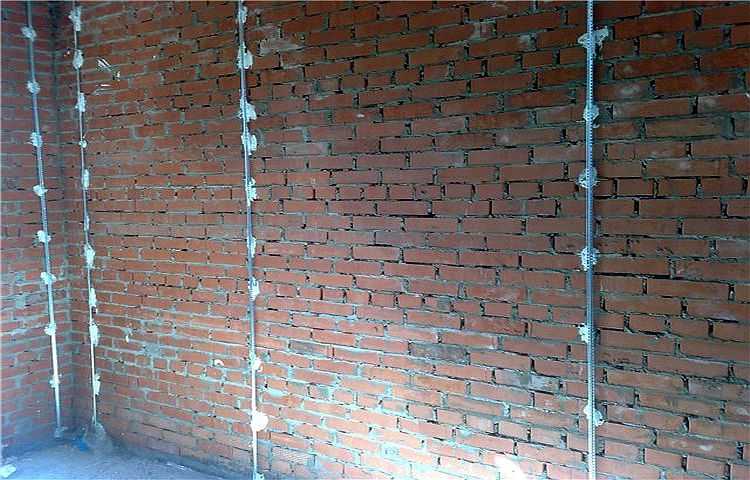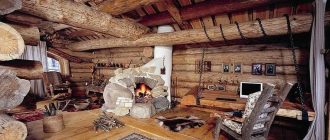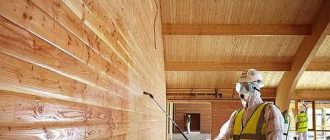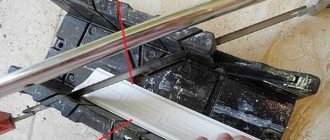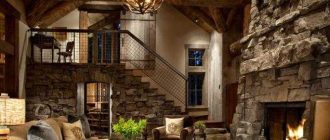When leveling the walls with a layer of plaster, a good result can be achieved if there are support strips – beacons. The same strips are needed when you pour the screed. Then the floor turns out to be even, without drops. How to put the beacons on the walls, under the screed and consider further.
Straipsnio turinys
Materials
Everything will be easier if there is a plane builder, but if not, you can do with an ordinary construction level. Only its length – at least 1.5 meters, and better more. And it is desirable to check it, so that deviations in the readings were not at all or, at least, that they were minimal.
How to put the beacons on the wall
Everything starts with an assessment of the wall differences. To begin with, it is necessary to find the most protruding point. If there is a laser level or a plane builder, you can use it. Set the beam parallel to the wall. And relative to this beam to look for the highest point on the wall.
If there is no laser device, take a long rule or just a flat long bar (about 2 meters long). To them tape a construction level and with the help of such a device determine where is the most protruding part of the wall. This is how to assess the verticality of the walls.
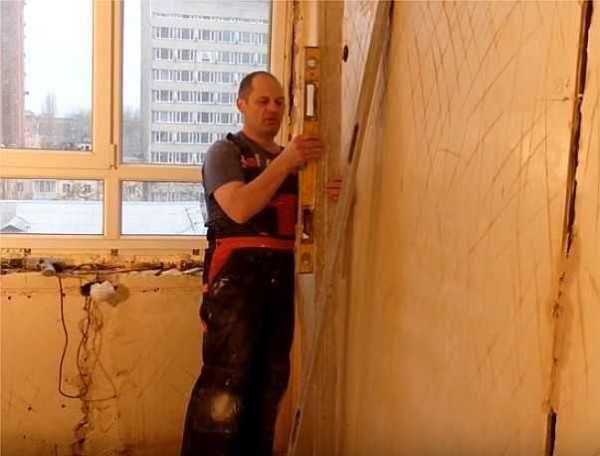
But there are also humps and depressions in the longitudinal plane. They can be “identified” with the help of a fishing line stretched at some distance from the wall. It can be tied to nails or self-tapping screws driven into the wall. They are tied to them at the same level and look where and how much the level deviates. Pass the entire plane, determining the most protruding point. At the same time, you evaluate the most “recessed”.
What is this for? The most protruding point is found in order to use the minimum layer of plaster: here it will be minimal. What layer will be next – depends on the curvature of the walls. The “deepest” point is found in order to choose the right plaster. In the technical data of any composition there are two important positions: the minimum layer and the maximum. You will need to choose so that your difference fits within these limits. For example, the well-known and popular plaster “Rothband” by Knauf has a minimum layer of 5 mm, the maximum – 50 mm. If this suits you, you can use it (it is gypsum).
Determining the number of beacon lines
The distance between the beacons depends on the tool with which you will “pull” the mortar – the rule. The most convenient – 1.5 meters. This tool should rest on two beacons, but up to the edges should still remain on each side of 15-20 cm. Therefore, when working with a rule of 1.5 meters, beacons are placed at a distance of 110-120 cm.

Marking starts from one of the corners. From it indent 10-30 cm – who knows how, and who is comfortable. At this level put a pencil or marker mark. And then mark out the lines with the chosen step. The distance between the beacons does not necessarily have to be the same. On the walls with door or window openings, it is mandatory to install plaster beacons on both sides, having set aside the same 10-30 cm. If the last gap remaining in the division is larger than the size of the rule, it is divided in half.
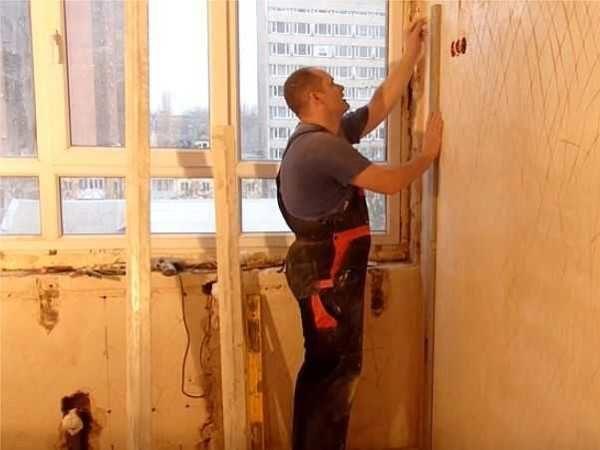
On the marks we draw vertical lines – on them we will screw screws. If there is a laser level, you can use it to set the marks without drawing lines. If there is no level, it is easiest to draw lines using a level – vertically up and down from the marks.
How to expose the beacons on self-tapping screws
The preparatory stage is over, the actual installation and alignment of beacons for plastering walls begins. There are several ways, but the most popular – with the use of screws or screws with a flat hat.
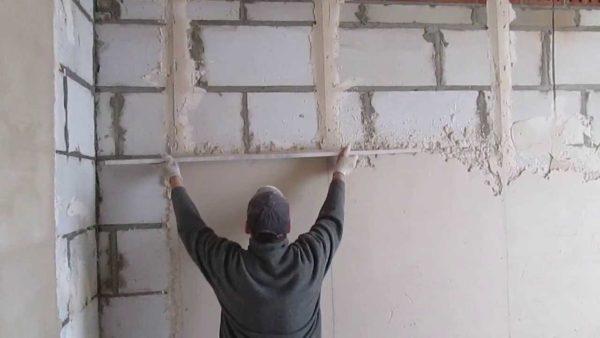
Alignment of self-tapping screws
Withdrawing from the floor and ceiling 5-10 cm painter’s cord (cord in blue) beat two horizontal lines on the wall. At the intersection of horizontals and extreme verticals (on which we will fix the beacons) screw in self-tapping screws. It turns out they are only 4 pieces: two at the top and two at the bottom. So far their height is arbitrary.
Then the height of screwed self-tapping screws should be set in one plane. From how accurately and correctly it will be done depends on the consumption of material for plastering and how smooth the walls will be as a result. Therefore, we try to do everything as accurately as possible. The order of actions is as follows:
After all the self-tapping screws are exposed, to be sure you check how faithfully you have done everything with the help of a rule or a level bar.
If the work was carried out without a plane builder, it may turn out that the stretched cord lies on a bulge on the wall. Then you will have to readjust all the self-tapping screws, starting with the first four. Very unpleasant, but it does not take much time.
Installing beacons
Dilute the composition, which we will use for plastering, a little thicker than indicated on the package. Near the screws (you can also between them), a little aside, we apply small molds of mortar with a trowel. Take a beacon bar, press it into the mortar to the right or left of the screws. The protrusion of the beacon should be at the same level as the screws.
Take a rule/plank and use it to align the beacon so that it is perfectly level. The metal on the beacon strips is often not very thick and can easily be bent. This is why this check is required.
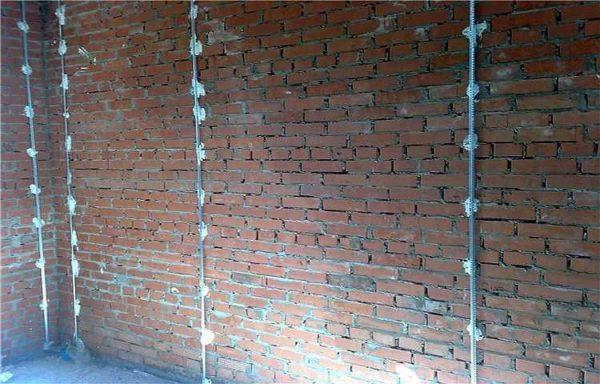
In the same way we set all the beacons, and then check that they were all in the same plane. Again take a level bar, but this time compare the installed beacon bars with each other. If necessary, correct them. After everything is level, we leave everything until the mortar dries (the exact time depends on the mortar). When it dries, you can start leveling the walls with plaster. Now you know how to expose the beacons under the plaster on self-tapping screws.
There are special fasteners for beacons, which allow you to do the same work faster. In any case, so say the authors of the idea and manufacturers of this fastener.
Beacons on self-tapping screws for the screed
Basically, the process differs at the stage of preparation – you need to determine the level of the screed and beat it off on the walls. When determining the thickness, it is worth remembering that the minimum layer of solution on the floor should be at least 3 cm. Otherwise, there is a high probability that the concrete will start to crack.
After determining the level of the screed, put a mark on one of the walls. Next, with the help of an electronic level (set in the mode of horizontal plane) or a water level, transfer the mark to all the walls, connect them with lines. Next, on these marks install self-tapping screws, to them tie twine and proceed to the installation and alignment of self-tapping screws on the floor.
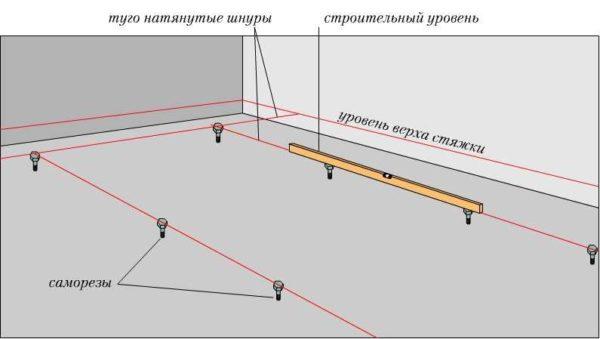
The number of beacons for floor screed is determined in the same way: based on the length of the rule: its length minus 20-30 cm. Place the beacon strips perpendicular to the wall where the entrance doors are located.
After all the self-tapping screws are installed and exposed in a single plane, near them also put piles of mortar. But not the one that will be used for the screed, but the one that sets faster – you can the same plaster on the basis of alabaster. Further it is necessary to set the beacons in the same way as for the walls: push them in up to the flats, check the level.
A faster way to install beacons for screeding
To implement this method, you must have a leveler (electronic plane builder) and gypsum plaster (you can take Rothband or any other). Determining the thickness of the screed is similar. Only since there is a builder, there is no need to draw something on the walls. We put only one mark.
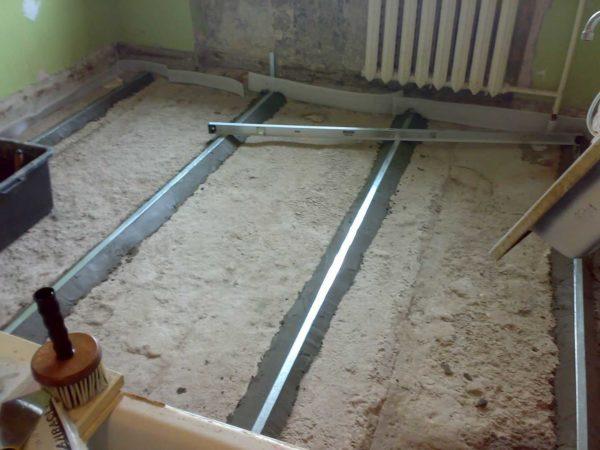
On the floor we lay out the beacon strips at the chosen distance. Along the strips at a distance of about 20 cm from each other on the prepared floor lay small cakes of gypsum mixture. Place the beacon on top of them. Turn on the plane builder and unfold the horizontal plane at about the level of your waist (it is convenient to work). Take a level bar, go to the place where there is a mark of the screed level, align the lower end of the bar with this mark. Above we see a glowing trace of the plane created by the leveler, on it we make a mark. This bar can be used to set the beacons at the same level. Put the bar on the beacon, press it until the beam of the leveler is not aligned with the mark. Move on. So pass along the entire beacon bar. Using the same technology put the rest of the beacons.
It really works faster, but there are two points. First – you need a leveler, and normal costs quite a lot. Second – there is no hard stop because of what it is easy to push the beacon lower than it should. You have to tear off, level the piles, start again. While you gain experience, a lot of time will pass too. But the method is quite good, if you know how to work carefully.

